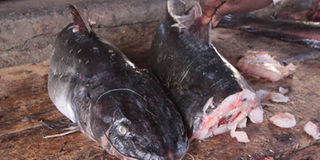Semutundu is the snake-like fish that many find a delicacy

Catfish on sale in Busega market. Photo by Ismail Kezaala.
What you need to know:
Catfish, which bears features resembling a cat’s whiskers, has charmed its way onto dining tables across Uganda.
For decades, before and after our independence, semutundu has remained a popular in Ugandan cuisine. That is neither coincidence nor mistake. There is every reason for the usually grey-black and creamy white (at the bottom) with a forked tail fin to occupy that special position in our cuisine.
Folk tales
Catfish, locally known as Semutundu in Buganda and ebileng in north-eastern Uganda, remains arguably the most intriguing fish species in Ugandan waters. Though tilapia and nile perch are the most popular fish species, semutundu has maintained a share of faithful clientele.
In a folk tale from north eastern Uganda, a narrative is told of an angler on night duty at Lake Kyoga who stumbled upon several catfish and panicked, making his boat capsize. He thought small snakes had invaded him!
“Personally I don’t eat semutundu, not even my children or wife. How does a true Christian eat something that looks like the serpent,” says Philemon Nsengiyunva, a self-styled staunch born again. Yet such beliefs, which come off as conservative, are what make the fish specie a delicacy in some circles.
Easy to consume
According to Jeremiah Muwereza from the Rwenzori region, semutundu has enjoyed unwavering popularity in his area, perhaps only in the ranks of the tilapia and Nile perch.
“Some people are put off eating fish because of the annoying small bones. That is what makes semutundu tick; its bones are not as many as those of tilapia for instance,” the angler speaks of why the fish is popular.
He adds that even among the fishing community, semutundu comes with less stress in terms of the laborious steps involved in getting it ready for sale to the final consumer.
“First of all, its size is usually manageable; it is not as obscenely big as a Nile perch though you can find some, which are really big, almost the size of a mature snake,” he says.
This eases its cutting open in preparation for preservation methods like sun-drying and smoking.
It is perhaps for this reason that a Koboko district based fish farmer since 1987 revealed to one of the dailies that he concentrates on catfish, Nile perch and tilapia and earns over Shs30m. This clarifies the misconception that semutundu has no economic value to it.
Mr Muwereza from a historical perspective notes that in the 1940s, until the early 1960s, semutundu played an integral role in the barter trade system. It was exchanged for other trade valuables among the communities just like any other fish specie.
Among most communities, this particular fish is preferred smoked, as it tastes better this way than when fried.
“Some people still love it fried with matooke and millet bread, but the traditional cook will opt for the smoked one because semutundu is best when pasted with groundnuts,” says Mercy Nakibirango, a waitress based in Kalerwe.
“When it comes to preparation, its smell is not as powerful as that of other fish, and the process is not as long when it is smoked,” she says.
As nutritious as any other fish
Semutundu comes with a wide range of health benefits; it is rich in protein and low in fat. According to internet sources, with its white flesh, this fish is lower in fat than any other source of animal protein. The oily semutundu is rich in omega a-3 fatty acids, the good fats.
“It works best for us the vegetarians, because the smell is not that terrible. We do not miss out on the proteins and other food nutrients in it,” she says.




